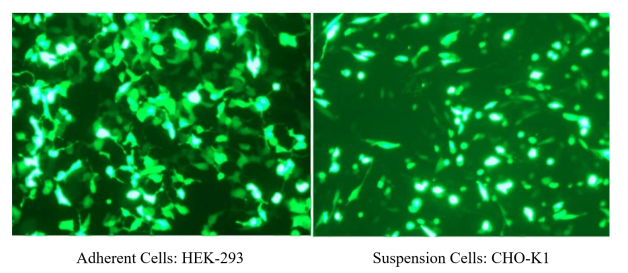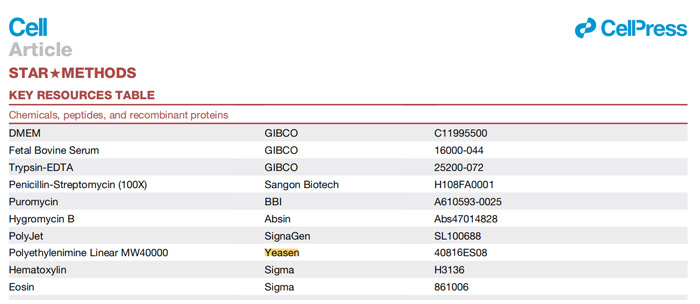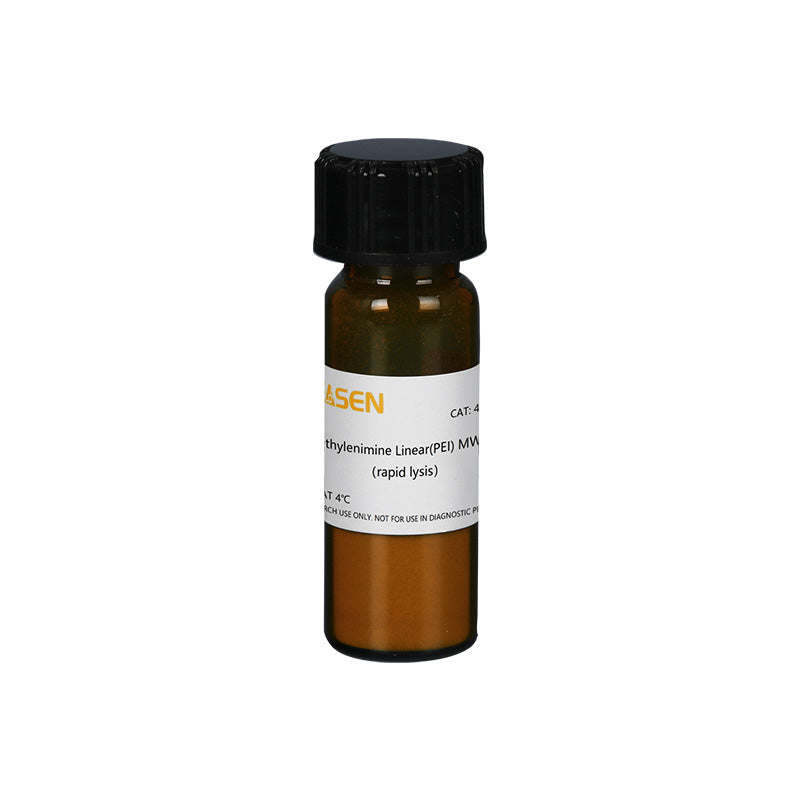Description
PEI 40000 is a highly charged cationic polymer with a molecular weight of 40,000 that binds negatively charged nucleic acid molecules very easily, forming a complex and allowing the complex to enter cells. PEI 40000 is a transient transfection reagent with low cytotoxicity, high transfection efficiency, and high gene expression efficiency in cells such as HEK293 and CHO.
PEI 40000 has many advantages over PEI 25000 Transfection Reagent. include:
1. PEI 40000 is easy to dissolve and can be directly dissolved in water. PEI 25000 needs to first adjust the water to weak acid to help it dissolve, and then use NaOH to adjust the pH to neutral.
2. PEI 40000 is easy to operate, easier to use, and has a better transfection effect than PEI 25000; 3. PEI 25000 contains 4-11% propionyl residues, which can prevent the polymer backbone from binding to DNA. Compared to PEI 25000, PEI 40000 is a complete shed construction, so its performance is consistently efficient.
This product is an instant type, which dissolves quickly and is easy to prepare.
Feature
- Exceptional Efficiency: Superior transfection performance in the broad range of cell lines, including transient transfection and stable transfection
- Wide Adaptability: Excellent transfection efficiency in a variety of cell lines and high levels of recombinant protein expression
- Low Toxicity: The activities of the diverse cells almost unaffected by transfection reagents from YEASEN
- Simple Operation: Proven efficacy in the presence of serum—eliminates the need to change media following transfection
- Cost Effective: Competitive transfection effect with more affordable prices
Application
- Cell Transfection
Specification
| Name | Polyethylenimine Linear (PEI) 40000 |
| CAS No. | 49533-93-7 |
| Molecular formula | (CH2CH2NH)n |
| Molecular weight | 40,000 |
| Solubility | Soluble in water, insoluble in organic solvents: benzene, ether and acetone |
| Structure |  |
| Form | White or off-white solid |
| Serum Compatible | Yes |
| Cell Type | Established Cell Lines |
| Sample Type | Plasmid DNA |
| Transfection Technique | PEI-Based Transfection |
Components
| Components No. | Name | 40816ES02 | 40816ES03 | 40816ES08 |
| 40816 | Polyethylenimine Linear (PEI) MW40000(rapid lysis) | 100 mg | 1 g | 5×1 g |
Shipping and Storage
The product is shipped at room temperature and the powder can be stored at 2-8ºC for two years. The stock solution is stored at 2-8 ºC for 3 months.
Figures
- Demonstration of Transfection Effect

Figure 1. The transfection efficiency of Polyethylenimine Linear (PEI) MW40000 Reagent was shown above.
Polyethylenimine Linear (PEI) MW40000 Reagents were used to transfect the HEK293 cell line and CHO-K1 cell line in a 96-well format. GFP expression was analyzed 48 hours posttransfection.
- Validated Cell Lines
| Product Name | Polyethylenimine Linear (PEI) MW40000 (Rapid Lysis) | |||
| Validated Cell Lines | COS-1 | CHO-K1 | HEK293 | HepG2 |
| COS-7 | Hela | HEK293T | NIH-3T3 | |

Cited from "TFPI is a colonic crypt receptor for TcdB from hypervirulent clade 2 C. difficile. Cell . 2022 Mar 17;185(6):980-994.e15. doi: 10.1016/j.cell.2022.02.010. "
Polyethylenimine Linear(PEI) MW40000(rapid lysis) FAQ
(1) Q: Can 40816 be made into 10× mother liquor and stored at -20℃?
A: It is recommended to store in accordance with the storage conditions of 2-8 ℃ in the instructions. Do not store at -20°C, use hydrochloric acid to make the pH slightly acidic, pH 6.8, and then store at -20°C,
However, the storage time cannot exceed one year. When using it again, take it out and measure the pH. If the pH is between 6.8 and 6.9, it can be used directly. Otherwise, the pH needs to be adjusted, and it cannot be frozen again to avoid repeated freezing and thawing. It is more troublesome and may affect the transfection efficiency, so it is not recommended.
[1] Luo J, Yang Q, Zhang X, et al. TFPI is a colonic crypt receptor for TcdB from hypervirulent clade 2 C. difficile. Cell. 2022;185(6):980-994.e15. doi:10.1016/j.cell.2022.02.010(IF:41.584)
[2] Chen Y, Luo R, Li J, et al. Intrinsic Radical Species Scavenging Activities of Tea Polyphenols Nanoparticles Block Pyroptosis in Endotoxin-Induced Sepsis [published correction appears in ACS Nano. 2022 Mar 3;:]. ACS Nano. 2022;16(2):2429-2441. doi:10.1021/acsnano.1c08913(IF:15.881)
[3] Chen ZH, Yan SM, Chen XX, et al. The genomic architecture of EBV and infected gastric tissue from precursor lesions to carcinoma. Genome Med. 2021;13(1):146. Published 2021 Sep 7. doi:10.1186/s13073-021-00963-2(IF:11.117)
[4] Huang G, Liu D, Wang W, et al. High-resolution structures of human Na<sub>v</sub>1.7 reveal gating modulation through α-π helical transition of S6<sub>IV</sub>. Cell Rep. 2022;39(4):110735. doi:10.1016/j.celrep.2022.110735(IF:9.423)
[5] Tian X, Liu L, Jiang W, Zhang H, Liu W, Li J. Potent and Persistent Antibody Response in COVID-19 Recovered Patients. Front Immunol. 2021;12:659041. Published 2021 May 28. doi:10.3389/fimmu.2021.659041(IF:7.561)
[6] Lin J, Chen Z, Yang L, et al. Cas9/AAV9-Mediated Somatic Mutagenesis Uncovered the Cell-Autonomous Role of Sarcoplasmic/Endoplasmic Reticulum Calcium ATPase 2 in Murine Cardiomyocyte Maturation. Front Cell Dev Biol. 2022;10:864516. Published 2022 Apr 1. doi:10.3389/fcell.2022.864516(IF:6.684)
[7] Nian F, Qian Y, Xu F, Yang M, Wang H, Zhang Z. LDHA promotes osteoblast differentiation through histone lactylation. Biochem Biophys Res Commun. 2022;615:31-35. doi:10.1016/j.bbrc.2022.05.028(IF:3.575)
Payment & Security
Your payment information is processed securely. We do not store credit card details nor have access to your credit card information.
Inquiry
You may also like
FAQ
The product is for research purposes only and is not intended for therapeutic or diagnostic use in humans or animals. Products and content are protected by patents, trademarks, and copyrights owned by Yeasen Biotechnology. Trademark symbols indicate the country of origin, not necessarily registration in all regions.
Certain applications may require additional third-party intellectual property rights.
Yeasen is dedicated to ethical science, believing our research should address critical questions while ensuring safety and ethical standards.

